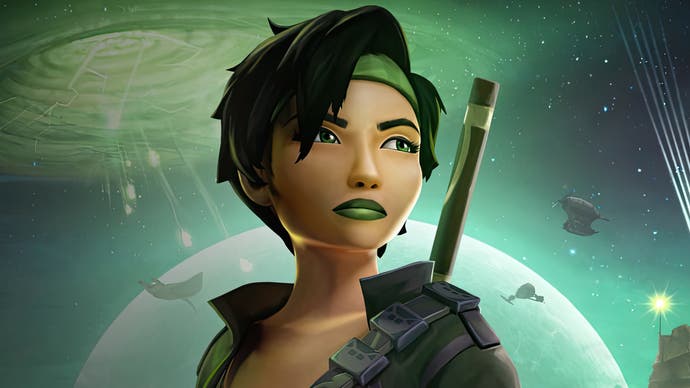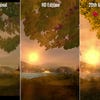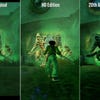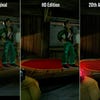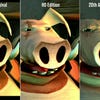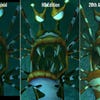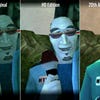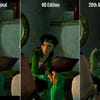Beyond Good and Evil's 20th Anniversary Edition: a near perfect way to revisit a classic
PS5, Xbox and Switch performance hiccups mar an otherwise well-crafted remaster.
Beyond Good and Evil's 20th Anniversary Edition is a near perfect remaster for fans of the 2003 original, with this cult classic's visuals improved over the previous HD release from 2011. Almost every texture, shader, and material is upgraded with a new asset - making for an often satisfying side-by-side comparison. Added to that, current-gen consoles like PS5 and Xbox Series X are also capable of running the game at 4K resolution at 60 frames per second. So from the outset, it's a slick upgrade that also thankfully avoids straying too far from director Michel Ancel and his team's original vision.
However, it doesn't stop there. Developer Ubisoft adds a generous dose of extras to the package here. Hours of making-of documents are crammed in: concept art, pre-release videos and even footage of removed levels and features make an appearance. It's genuinely fascinating stuff, letting us see the evolution of the project through each E3 demo build, and it's all round a great chance for Ubisoft to mine its vaults for a deep-dive into the game's history. For this bonus section alone it might be worth the price of entry for the hardcore fans. On top of that, there's a new speed-run mode, and just as tantalisingly, content added later in Beyond Good and Evil's adventure links it to the long-awaited prequel project.
For the initiated fan then, the 20th Anniversary Edition offers a wellspring of new information. It also gives us some much-needed encouragement in Ubisoft's plans for a follow-up, even if - 16 years on from its original announcement trailer - there's still no confirmed release date. And most crucially, the remaster gives newcomers a perfect way to jump in and to understand what made the original game so special. For this piece, we're actually looking at three versions of the game: the original 2003 release, the 2011 HD release (effectively a 720p reworking with some improved textures for Xbox 360 and PS3) and finally, the recently published 20th Anniversary edition, with its 4K/1440p resolution upgrade.
The res boost is just one part of the package of course. The revised HUD elements - the text, menus - all get a sizeable overhaul to suit the final output. Equally, the actual in-game assets see a stark upgrade. Practically every texture is reworked with a newer pin-sharp version: the ground textures, the skybox filling the nighttime horizon with stars - these are all replaced. Some textures fall much closer to the original and HD version in quality, while others potentially use an AI upscale to repurpose the original asset - most notably the shop signs across Hillys. A majority of materials are clearly built from scratch though, adding more complex shader effects in the process that simply would not have been possible in 2003. On the whole, the result is effective, in retaining the original design, albeit with a sharper, cleaner resolve to 4K.
It's great stuff. Being such a narrative-driven game in nature, this overhaul is often best applied to Beyond Good and Evil's characters. Their jackets, hats and tops now reveal a more fabric-like effect in close-up. It's clear that their basic geometric design is broadly intact from the original - so it's often a surface-level tweak, but a satisfying one. Even the Pterelomax boss is upgraded with a scaly material design up and down its body, where before we had a flatter-coloured texture. On the whole, these changes heighten the effect of the original, intended design. It's also to Ubisoft's credit that it's dug deeper on lesser-known characters that more desperately needed a visual upgrade - or elements that simply wouldn't have held up at 4K, left untouched. For one, the residents of the opening Lighthouse area now actually have individual fingers, rather than simplified Lego-style claws. You'll spot a great many subtle changes across Beyond Good and Evil's world, too: a new crumple to the a carpet in Jade' room, and added grass tufts to the view outside. All round, it lends each area a subtle 'lived-in' feel without going overboard.
Needless to say all of these upgrades apply to all console versions, and PC. All current-gen consoles have a mode selection toggle: letting us go between resolution mode and performance mode. Taking PS5 as an example, the resolution mode runs at a fixed 4K resolution, and at 60 frames per second. The drawback being occasional, jarring lurches to 30fps. The game appears to use a double-buffer style v-sync, meaning any drop under 60fps will trigger the game to target 30 instead, for a few second's spell anyway. It happens typically during a sudden burst of alpha effects - transparent effects like a close-up of Pey'j using his rocket boots, or a fly-over across Black Isle. At times it's a distraction to the gameplay itself: in one moment we're given the ability to fire projectiles - but the zoom function fills the frame with alpha effects which tumble the frame-rate. All of this happens on PS5, and Series X on that 4K resolution mode - but honestly, 99 per cent of the experience is locked at 60. It's simply that these drops are highly noticeable and jarring when they do occur.
Fortunately, there's a fix for PS5 and Series X. The alternative performance mode essentially drops the pixel count to 1440p, where the upshot is fewer jarring drops. It's not a perfect solution and there are still performance dips, but they're nowhere near as distracting as the 4K resolution mode. Still it's a shame to see them at all. For context, playing the now delisted 2011 HD version - the Xbox 360 release via back combat on a Series X - gets you a smooth 60fps throughout. There are no drops, but it also misses out on all the visual upgrades. Meanwhile, looking at Series S running the 20th Anniversary Edition, the setup makes less sense by comparison. You get 1440p on the resolution mode on Series S, but switching to the performance mode on Series S shows no difference in my testing. It's still 1440p regardless. All of which means, regardless of mode, you will have a 60fps experience typically, but blighted by sudden nosedives in frame-rate in select spots. Unlike PS5 and Series X, there's currently no lower-resolution option - even a 1080p option - to limit the impact of these 30fps drops on Series S.
The Nintendo Switch release is a much more interesting - and frustrating - release by comparison, as is so often the case. The game retains many of the features of the PS5 and Series X version, but with select visual downgrades. On the upside, Switch's resolution while docked varies between 900p and 1080p depending on the situation. Most dungeon areas trend towards that maximum 1080p figure, while the canal area at the centre of Hillys - with all the flying cars - turns out numbers closer to 1600x900. Still, it's impressive stuff given that the system simply cannot output anything higher. In terms of resolution, Switch's portable mode also typically has the game run at the maximum possible 720p. It's a perfect pixel match for the display, and looks crisp while playing on the go. However, there are cutbacks, most notably with a hit to texture detail and materials work.
It's a mixed result on Switch all round, but most environmental textures are at least better than the HD version from 2011. We keep the improved geometry on minor character's fingers. We keep the crumpled carpet in the Lighthouse room. However, elsewhere, Switch's smaller pool of 3.GB of usable RAM necessitates a cut to texture and shader quality. I think one of the most stark differences is in reflections, in truth: every reflected element runs at half the resolution of PS5, and without any gaussian blur on Switch, the resulting stair stepping sticks out.
Switch also has a 30fps cap, which is disappointing given that it's fundamentally such an old game. It's an evenly frame-paced 30fps at least, which is a positive. Also in fairness, the game appears to prioritise the best resolution targets for the system: 1080p docked and 720p portable. The main issue is that these targets are evidently too high and too ambitious to carry the whole game at its intended 30fps. The game drops heavily under the line at select points - again with a double-sync style logic that locks on to specific increments. 20fps is possible, and even 12fps is a reality when stood in the wrong place at the wrong time. Alpha transparencies are the culprit again, just like PS5. Stand under a waterfall, fill the frame with effects, and Switch's GPU is bottlenecked, the result being a continuous 12fps reading. This is a manufactured situation of course, but you'll notice it enough during actual gameplay that it's worth flagging. Battles with too many enemies on-screen can also bring the frame-rate to the 20fps line.
This is frustrating given that we've had releases of the game - even the original Xbox or GameCube versions - which could run at 60fps at points. Sure, the original Xbox version runs at a lower 480p resolution, and without the texture and shader improvements. It ran at an unlocked frame-rate, between 30 and 60fps in reality, but if decades-old consoles can get that close, Switch should be able to better that result a full two decades on.
That - in a nutshell - is how the 20th Anniversary Edition lines up on consoles today. Later content bridges the game with Beyond Good and Evil 2, making this the most definitive, most convenient way to jump in if you haven't already. Our only real gripe beyond what's covered so far concerns in-game bugs: mostly this is limited to small gripes like flickering textures - but sadly I've had one black screen freeze on selecting Exit to Menu. It was easy to pick up from the last save game via the auto-save feature, but still it's something to be wary of. Beyond that though, this is a strong way to get reacquainted with Beyond Good and Evil as we wait for its sequel - or to experience the game for the first time.
